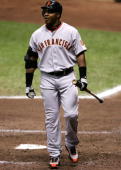
With Barry Bonds arriving in Philadelphia for a weekend set, I decided to re-publish this piece which originally ran in the inaugural issue of The Phanatic
By John McMullen
While Major League baseball and its best player -- Barry Bonds -- remain in the crosshairs of the public over their continued steroid problems, America's real national pastime, football, is getting a free pass.
Why?
While both entities are monopolistic giants generating billions every year, the NFL and NCAA have both realized the importance of a good public relations arm, whereas baseball's chief brain wizard, Bud Selig, continues to struggle with that seemingly, innocuous notion.
More than one year ago, MLB asked its Players Association for a more stringent drug policy, including administration of the program by an independent expert and increased levels of punishment that would result in a lifetime ban upon a third offense.
Sounds impressive, but while we all waited for the typical Donald Fehr dodge and parry response, the NFL and the NCAA developed a similar policy over a decade ago.
The dirty little secret, though, is that the NFL and the NCAA's policies simply don't work, and neither will MLB's.
Stopping performance enhancing drugs in any sport is impossible, and anyone who tells you different is either uninformed or a con man.
Human Growth Hormone is the current rage among the privileged in sports. While very expensive, it is not detectable in any test. Same goes for blood doping and at least a dozen or so other designer steroids -- just ask Bonds.
Simply put, those who can afford the aforementioned options can sleep worry free while struggling fringe players like a low-level minor league baseball prospect are stuck using the detectable stuff.
Don't think so?
Consider this: Dozens of Minor League players have been suspended by baseball's new program while only one notable player was nabbed, Rafael Palmeiro. No Bonds, No Giambi, No Sosa.
And Palmeiro was caught using stanozolol or winstrol (to the uninitiated, an easily detectable steroid that is cheap and likely tells us more about Raffy's IQ level than the seriousness of any drug testing policy).
While the NFL deserves some credit for being the first major sports league to test for performance-enhancing drugs, it has been a system without teeth. The league began testing 16 years ago and has suspended just 54 players. While the Bill Romanowski's skated through their careers, it's the Artie Ulmer's and Bob Sapp's of the world that are caught in Paul Tagliabue's tainted dragnet.
The NCAA hasn't been much better. The most recent publicly-released figures show positive tests for about one percent of football players involved in random and bowl-game testing, while three percent of the athletes admit to steroid use.
Jason Scukanec, who played at Brigham Young and later on the practice squads of the Denver Broncos and Tampa Bay Buccaneers, says steroids are prevalent in many Division-I programs.
"I would bet my house you could find at least five guys on every Division I team in the country (using steroids)," Scukanec told the Portland Tribune.
"Over the course of my five years at BYU, I have concrete proof of 13 to 15 guys (using steroids), and I would suspect five others," added Scukanec. "And BYU is more temperate than most programs. I know other schools are worse."
Is Scukanec right? .
If teenage girls are taking steroids just to look good to their awkward suitors, what are the odds that a few of our comic-booked sized football favorites are gassed? Common sense says pretty good, but you wouldn't know it by the number who have been snared by the system.
When one famous study declares that up to seven percent of middle school girls say they have used steroids, and the NCAA says one percent tested positive, what does that tell you about its policy?
Since the '70s, football players have grown in ways that evolution and competent eating habits can't fully explain.
The players aren't just bigger -- they are faster, stronger and quicker.
As a society, we don't want to believe our heroes could be tainted.
What the NFL and NCAA now knows and baseball hasn't quite figured out is that if you jump through the country's public relations hoop you can go on doing exactly what you want to do.
The reality is that many fans will exchange the sanctity of the game for a more entertaining product.
Ask yourself if you want to go back to the days when centers anchored the offensive line at 240 pounds or Thurman Munson won the A.L. MVP award with 17 home runs; if the answer is anything other that yes, get in line with the hypocrites that run major league sports.
For those who don't want to go back to the future and enjoy watching 330-pound tackles pull like bloated gazelles or Barry smack a 450-foot home run, you are among the large group that believe steroids shouldn't be banned.
Dozens of doctors believe it, and the American Health Association and the Drug Enforcement Administration argued exactly that when Congress decided to make them a controlled substance in the early '90s. And, more significantly, sports' big wigs realize that enhanced performance equals more viewers, and therefore, more money.
Every league, in one degree or the other, is culpable for allowing steroids to become such a major part of the sports landscape. The only difference between MLB and football is that the latter is more efficient at publicly rejecting it.
The truth is that the steroid era has been alive and well for thirty years, in all sports.
Don't blame Barry.
-You can reach John McMullen at jmcmullen1@comcast.net

No comments:
Post a Comment